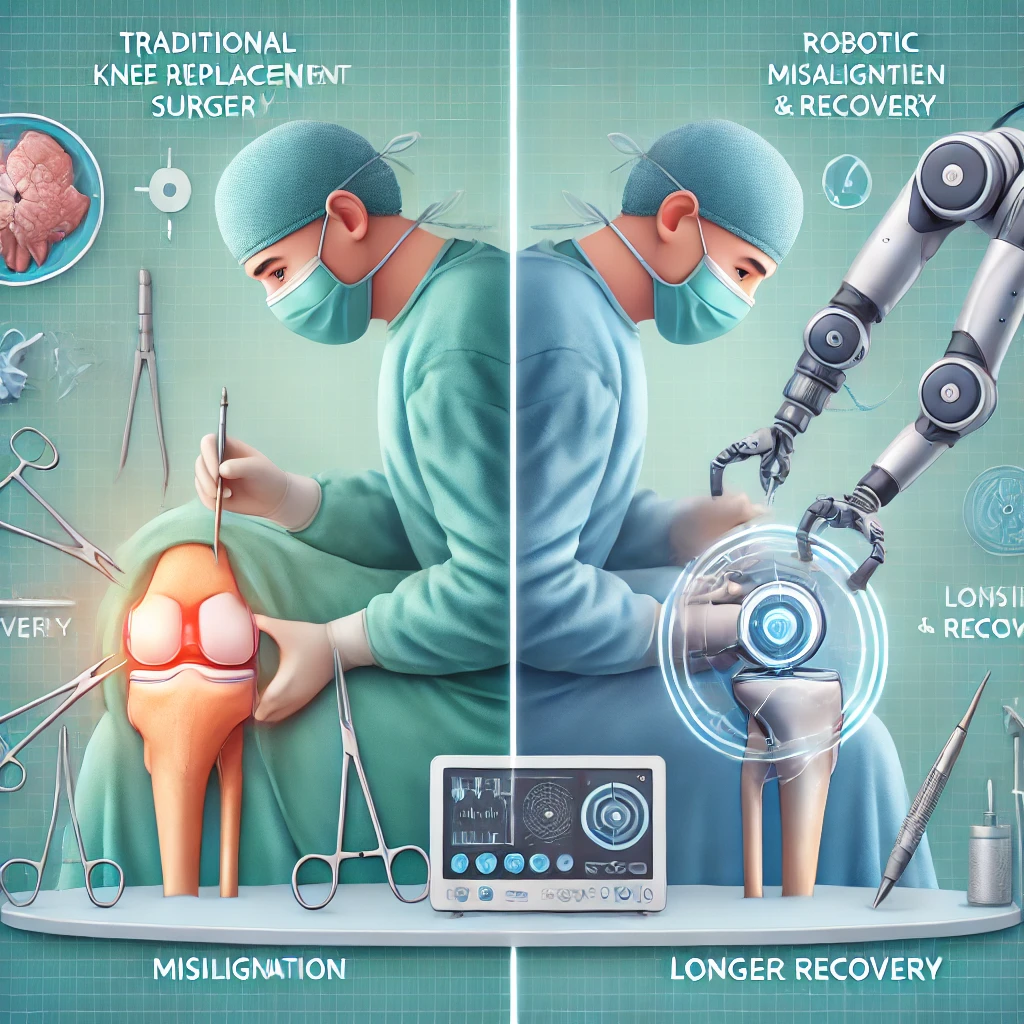Comparing Traditional and Robotic Knee Replacement
Published on: 2025-01-18
No matter which surgery technique is chosen for knee replacement surgery, its success hinges largely on rehabilitation efforts undertaken post-surgery as per doctor orders. Robotic knee replacement allows our surgeons to use an arm equipped with precise laser technology to cut bone precisely and make real-time adjustments, so your new implant fits and feels natural.
Cost

Knee replacement surgery is a popular solution to treat severe knee pain. Traditional knee replacement procedures involve surgeons manually cutting away sections of tibia and femur to install artificial parts into new joints; robotic knee surgery allows surgeons to use robotic arms for more precise cuts and measurements, potentially improving long-term surgical outcomes while increasing overall costs of procedures.
At a robotic-assisted knee replacement procedure, a surgeon uses a camera to view the knee and its surrounding tissues, before controlling a robotic arm with hand tools to perform various tasks such as cutting bone or removing damaged cartilage from your knee. Furthermore, test implants may also be placed during this phase in order to establish the best placement of final implant(s).
Researchers utilized data from the National Inpatient Sample, a publically available database that collects hospital stays across the U.S. They then compared costs associated with conventional and robotic TKA procedures - including their costs related to surgery itself, hospital stay duration, complications, ICER analysis and INMB analysis to measure cost-effectiveness of each approach.
In their study, the authors discovered that robotic TKA was more cost-effective than traditional TKA at hospitals with high annual procedure volumes; however, at low volume hospitals the difference in ICERs between robotic and traditional TKA procedures was minimal.
Complications

Traditional knee replacement procedures involve extracting damaged cartilage and bone from the knee joint and replacing it with metal, plastic, or ceramic implants. This procedure should only be considered when knee pain and stiffness significantly diminish one's quality of life. In order to perform such surgery safely and successfully, an incision must be made at the knee area so arthroscopic instruments may be used to access and remove unhealthy portions from the joint.
At robotic surgery, surgeons use robotic arms to assist them in specific areas of surgery. By controlling this arm with their hand, they can position new artificial joints while also adjusting ligament tension, soft tissue balance and bone alignment of their knee joint for greater precision and improved surgical outcomes.
Although robotic surgery provides increased accuracy and precision, there may still be complications related to its use. Pin-site femoral and tibial fractures are among the more serious side effects, which occur when the robotic arm leaves its site of incision and impacts nearby tissues or bones - these injuries may be difficult for patients to overcome, but physical therapy treatment options exist to address them.
Recovery

Robotic knee replacement surgery offers patients an expedited recovery time than conventional operations. This minimally invasive process reduces patient discomfort and recovery times while decreasing blood loss and even permitting same-day surgery in many instances.
Procedure involves using a surgical arm equipped with sensors capable of recognizing bone and tissue for precision in surgery. This enables surgeons to remove only damaged areas of a knee joint for more natural feel and reduced friction with surrounding soft tissues; and create better implant alignment and positioning.
Additionally, the robot can track the position of the knee during surgery to ensure proper alignment, ligament tension and balance are achieved, leading to improved knee function and reduced risk of future revision surgery.
Under general or local anesthetic, robotically assisted surgery can be completed either under general anesthesia or with local anesthetic alone. When performed without using a tourniquet, this helps preserve normal structure and functions of the knee joint while reducing risks caused by using tourniquets such as nerve or blood vessel damage and dislocation of prosthetic knee replacement devices. Furthermore, patients can start rehabilitation directly after the operation without needing too many follow-up appointments postoperatively.
Pain

Orthopedic surgeons are adept at performing precise bone cuts and implant placement. Robotic surgery based on preoperative imaging and finding anatomical landmarks during an operation aims to increase both accuracy and safety during operations.
Robotic arms don't perform surgery by themselves; rather, they serve as aids for surgeons in areas that require steady hands or maneuvering tight spaces. Furthermore, robotic arms may help surgeons avoid incisions that might cause bleeding or infection and potentially reduce soft tissue damage.
Studies show that patients undergoing robotic-assisted total knee arthroplasty (TKA) experience greater success, such as lower hip-knee-ankle angles and greater Oxford knee scores than with traditional TKA. Furthermore, their knee function improved in terms of range of motion as well as more natural movement than before surgery.
Robot-assisted TKA has also been associated with reduced pain and opioid usage after surgery; however, this doesn't translate directly to faster recovery times; pain control depends on multiple factors - how often narcotics are needed, the body's reaction to the anesthesia used and also on the surgical procedure itself.
Lee Health orthopedic surgeons are specially trained to determine your eligibility for robotic knee replacement and will work with you to find the optimal treatment option for you. Give us a call now so we can give you pain-free mobility so you can return to doing what you love!

 +91 98551-63355
+91 98551-63355















